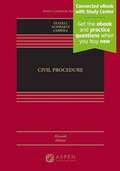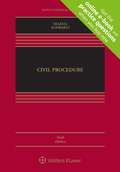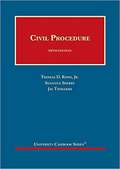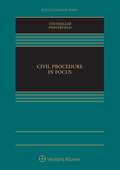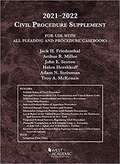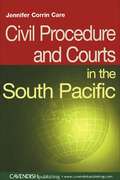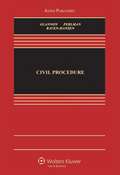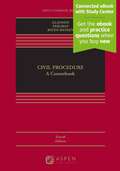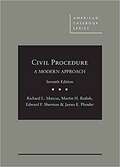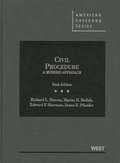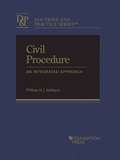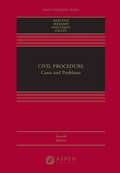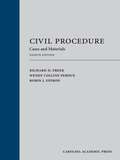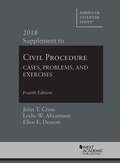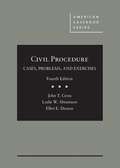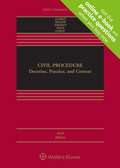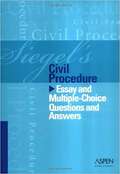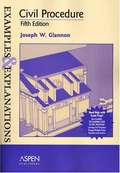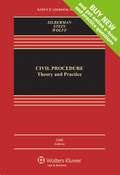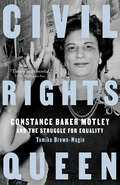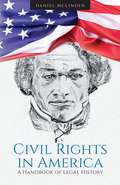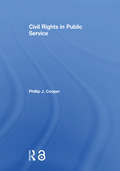- Table View
- List View
Civil Procedure (Aspen Casebook)
by Stephen C. Yeazell Maureen Carroll Joanna C. SchwartzCivil Procedure, 11th edition by Yeazell, Schwartz, and Carroll provides students with a working knowledge of the procedural system. In Civil Procedure, the authors employ a pedagogical style that offers flexible organization at a manageable length. The book introduces students to the procedural system and provides them with techniques of statutory analysis. <p><p>The included cases are factually interesting and do not involve substantive matters beyond the experience of first-year students. The problems following the cases present real-life issues. Finally, the book incorporates a number of dissenting opinions to dispel the notion that procedural disputes always present clear-cut issues.
Civil Procedure (Aspen Casebook)
by Stephen Yeazell Joanna SchwartzIn Civil Procedure, Tenth Edition, the authors employ a pedagogical style that offers flexible organization at a manageable length. The book gives students a working knowledge of the procedural system and introduces the techniques of statutory analysis. The cases selected are factually interesting and do not involve substantive matters beyond the experience of first-year students. The problems following the cases present real-life issues. Finally, the book incorporates a number of dissenting opinions to dispel the notion that most procedural disputes present clear-cut issues.
Civil Procedure (University Casebook)
by Suzanna Sherry Thomas Rowe Jr. Jay TidmarshCIVIL PROCEDURE FIFTH EDITION
Civil Procedure In Focus (Focus Casebook)
by Jeremy Counseller Eric PorterfieldCivil Procedure in Focus uses a combination of accessible explanatory text, cases, and other primary legal sources to teach civil procedure, and then provides opportunities to apply the law to multiple sets of facts in every chapter. Instead of using the “hide the ball” approach of traditional casebooks, selected cases illustrate key changes in the law and show how courts develop and apply doctrine. The approachable manner of this casebook provides a comfortable experiential environment that is essential to student success. With this new text, students apply concepts to real-world scenarios. Simply knowing the facts of a benchmark case is not enough: knowing how to apply the doctrine in a case to a different set of facts enhances a student’s ability to succeed after law school. Key Benefits: Case Previews and Post-Case Follow-Ups. To succeed, law students must know how to deconstruct and analyze cases. Case Previews highlight the legal concepts in a case before the student reads it. Post-Case Follow-Ups summarize the important points and go one step further—noting the significance of a case to current law as well as its later ramifications. Real Life Applications. Every case in a chapter is followed by Real Life Applications, which present a series of questions based on a scenario similar to the facts in the case. Real Life Applications challenge students to apply what they have learned and help prepare them for real-world practice. Professors can use Real Life Applications to spark class discussions or provide them as individual short-answer assignments. Applying the Concepts and Civil Procedure in Practice. These end-of-chapter exercises encourage students to synthesize the chapter material and apply relevant legal doctrine and code to real-world scenarios. Students can use these exercises for self-assessment or the professor can use them to promote class interaction.
Civil Procedure Supplement, For Use With All Pleading And Procedure Casebooks, 2021-2022
by Arthur Miller John Sexton Jack Friedenthal Helen Hershkoff Adam Steinman Troy McKenzieThis supplement is an up-to-date source for the Federal Rules of Civil Procedure and notes of advisory committees, plus other materials important for teaching Civil Procedure and advanced procedure courses, including selected provisions from the U.S. Constitution, U.S. Code and proposed legislation, state constitutions and state jurisdictional statutes, federal local rules, and Rules of Appellate Procedure. It also contains edited versions of recent cases of the Supreme Court of the United States, and provides materials for experiential learning that can be used even if teaching remotely, including a Flow Chart of a Civil Action, an Illustrative Litigation Problem with Sample Documents, and the complaints in Twombly, Iqbal, and Erickson v. Pardus.
Civil Procedure and Courts in the South Pacific
by Jennifer Corrin-CareThe book compares the main rules of procedure that govern the conduct of civil cases in countries of the South Pacific region and explains their practical application in the context of the courts in which they operate. The text focuses on the rules that apply and on the High Court (Civil Procedure) Rules of 1964, which apply in the superior courts of Kiribati, Tuvalu and Solomon Islands, and the rules that apply in the superior courts of the Fiji Islands, Samoa and Tonga. It also fully discusses the new rules of civil procedure that are currently being introduced in Vanatu. The text describes recent changes to regional civil procedure rules and suggests further reforms. Legislative and case law developments are also discussed. This book is designed for use by legal practitioners and anyone interested in civil procedure in the South Pacific region. It will also be of use to teachers and students of South Pacific civil procedure, both at degree level and in professional legal training programmes.
Civil Procedure: A Coursebook
by Joseph W. Glannon Peter Raven-Hansen Andrew M. PerlmanCasebooks generally present a series of cases followed by notes and questions, but the authors of this text saw the need for something different. They wrote this coursebook with features that are student-friendly. Each chapter begins with a summary, and each case begins with an introduction that includes questions to think about before reading the case. Notes and questions follow, but this work differs from others in that almost all the questions are answered. Ease of use and clarity shaped the design and organization of the book (e. g. short chapters, the use of fonts and borders to designate types of text, summaries of key concepts). Material is presented in chapters on subject matter jurisdiction, personal jurisdiction, venue, pleading, joinder and supplemental jurisdiction, discovery, choice of law, trial and pretrial, and after final judgment. Joseph W. Glannon and Andrew M. Perlman are affiliated with Suffolk U. , and Peter Raven-Hansen, with George Washington U. Annotation ©2011 Book News, Inc. , Portland, OR (booknews. com)
Civil Procedure: A Coursebook (Aspen Casebook)
by Joseph W. Glannon Peter Raven-Hansen Andrew M. PerlmanCivil Procedure: A Coursebook offers students doctrinal clarity without sacrificing analytical rigor or glossing over ambiguities. The book's accessibility, organization, and interior design support its innovative pedagogy making it the ideal text for any civil procedure course. <p><p>New to the Fourth Edition: <p>•New case treatment of personal jurisdiction in the Internet context. <p>•New cases and materials for affirmative defenses (qualified immunity), class certification (stop and frisk policy), summary judgment (police shooting/qualified immunity), and issue preclusion (official misconduct), helping students connect procedure to current social issues. <p>•New case treatment of proportionality in discovery. <p><p>Professors and student will benefit from: <p>•Nearly all questions asked are answered in the book <p>•Each chapter includes mini table of contents at beginning and summary of fundamentals at end <p>•Each case prefaced by accessible introduction <p>•Interior design and graphics support innovative pedagogy
Civil Procedure: A Modern Approach
by Richard Marcus Martin Redish Edward Sherman James PfanderSince it first appeared, this casebook has sought to capture the evolving challenges of civil procedure in a way that engages students and fosters critical judgment on the underlying policy issues. The authors have closely monitored the evolution of procedure over this time, and adapted the basic structure of the book to take account of those changes. <p><p> That evolution remains central to the seventh edition. The new edition retains the basic structure of the book, and a great deal of the existing superstructure of principal cases. It adds substantially revised text and note material to present contemporary issues in the context of those cases or new principal cases. The discovery chapter, for example, is infused with coverage of the 2015 rule amendments that have received so much attention. The personal jurisdiction chapter integrates the many recent Supreme Court decisions into the existing framework, conveying the developments that have occurred since the last edition appeared in 2013. <p><p> The new edition also offers new principal cases to examine and illustrate a number of issues. A new Rule 19 case on required parties presents the contemporary issues in a setting likely to be interesting to many students. A new Internet jurisdiction case involves online payday lending, an example of the fast-moving world of Internet-based commerce. A recent supplemental jurisdiction case enables students to work through the application of § 1367 in a setting that also involves appreciation of various joinder concepts. A new class-action case presents the challenges of consumer class actions. New Supreme Court and other principal cases address issues of subject matter jurisdiction and appellate jurisdiction. As reflects contemporary litigation, intellectual property cases are more prominent than in previous editions.
Civil Procedure: A Modern Approach (Sixth Edition)
by Martin H. Redish Richard L. Marcus Edward F. Sherman James E. PfanderThe sixth edition of this successful casebook continues the authors' commitment to providing professors and their students with the tools to address both foundational questions and cutting edge procedural issues in a practical way that is attuned to today's legal practice. It contains an expanded treatment of the increasingly important topic of pleading practice, and additional emphasis on electronic discovery issues. It also offers carefully edited versions of recent Supreme Court cases like Ashcroft v. Iqbal and J. McIntyre Machinery, Ltd. v. Nicastro, along with textual and note material to identify and highlight the critical issues. The class-action section contains presentations on Wal- Mart v. Dukes and the key issues raised by the Court's decisions on class-action waivers in arbitration clauses that are appropriate for first-year students. Throughout, the material has been updated and revised to focus on the critical issues of 21st century practice. As with prior editions, the authors will provide a thorough Teachers' Manual, which they will supplement with annual Teachers' Updates to keep teachers entirely up-to-date.
Civil Procedure: An Integrated Approach
by William HubbardCivil Procedure: An Integrated Approach (Doctrine and Practice Series) combines classic cases, contemporary lower-court gems, and an unmatched set of learning tools and teacher resources to make civil procedure accessible, relevant, and compelling. The hardcopy textbook is integrated with online flowcharts, quizzes, and videos that together give students of all learning styles a strong command of doctrine. It emphasizes the central role of lawyers in civil procedure, challenging students to discover the legal strategies and practical realities that make civil procedure the most important element in every litigator’s toolkit.
Civil Procedure: Cases and Materials (American Casebook)
by Helen Hershkoff Jack H. Friedenthal Arthur R. Miller John E. SextonThe Twelfth Edition of this very popular casebook provides a framework for studying the essential and cutting-edge issues of civil procedure in an accessible but rigorous way. The materials are designed to reinforce doctrinal understanding, to foster case reading skills, to encourage critical thinking about the real-world context of procedural decisions, and to help develop a sense of litigation strategy. <p><p> The casebook covers all of the major topics that a professor might wish to teach in a first-year course, and can easily be adapted for courses of one- or two-semesters, of different credit hours, and with varied practical or theoretical emphases. A supplement includes all updated Federal Rules, federal statutes and constitutional provisions pertinent to procedure, the pleadings in Twombly and Iqbal, a model case file, a litigation flow-chart, state materials, and other important teaching tools.
Civil Procedure: Cases and Materials, Compact Edition for Shorter Courses
by Arthur Miller John Sexton Jack Friedenthal Helen Hershkoff Adam Steinman Troy McKenzieThe Compact Thirteenth Edition of this very popular casebook is designed for three- or four-credit civil procedure courses. It provides a framework for studying the essential and cutting-edge issues of civil procedure in an accessible but rigorous way. The authors of the prior editions, Jack H. Friedenthal, Arthur R. Miller, John E. Sexton, and Helen Hershkoff, welcome two new authors to their team, Adam N. Steinman and Troy A. McKenzie. The new edition reflects the uniqueness, talents, and special expertise of these new authors, who individually and together bring tremendous new experiences and backgrounds to an author-team already known for its excellence and distinction. Adam N. Steinman, the University Research Professor of Law at the University of Alabama School of Law, is an award-winning teacher and scholar whose work has been cited in hundreds of articles and dozens of judicial opinions. He is an author on the Wright & Miller Federal and Practice & Procedure treatise and an elected member of the American Law Institute. He is also the co-organizer of the Unavailability Workshop for Civil Procedure and the co-editor of the Law Professor Blogs Network’s Civil Procedure & Federal Courts Blog. Prior to joining the University of Alabama faculty, he was a Professor of Law at Seton Hall University and the University of Cincinnati. His practice experience includes both complex civil litigation and public-interest appellate work. Troy A. McKenzie, Professor of Law at New York University School of Law, is an award-winning teacher and scholar who has taken an active role in the procedural rulemaking process.
Civil Procedure: Cases and Problems (Aspen Casebook)
by Toni M. Massaro Barbara Allen Babcock Norman W. Spaulding Myriam E. GillesCivil Procedure: Cases and Problems, Seventh Edition by Barbara Allen Babcock, Toni M. Massaro, Norman W. Spaulding, and new co-author Myriam Gilles (the #5 most cited civil procedure scholar in the country) is the ideal casebook for the modern Civil Procedure course. With lightly-edited cases, both canonical and contemporary, and engaging hypothetical problems, the Seventh Edition of Civil Procedure: Cases and Problems promotes student understanding of modern procedure, the adversary system and alternatives, the relationship between substance and procedure, and systemic problems in access to justice. <p><p>This casebook pioneered the “due process approach” to the study of procedure and is designed to create an inclusive learning environment, emphasizing the formative role of public interest litigation in modern procedural law and the voices of women and people of color in shaping the field in both practice and scholarship. It is the only major casebook on the market written by co-authors who together have received more than a dozen awards for excellence in teaching.
Civil Procedure: Cases, Materials, and Questions
by Richard D. Freer Wendy Collins Perdue Robin J. EffronThis innovative casebook is designed to be accessible to first year students while exposing them to the richness of the course. Each chapter begins with an ''Introduction and Integration'' section, which provides an overview and indicates how the materials relate to other topics. The authors explore the strategic and ethical issues faced by lawyers. The book features clear textual explication to set up consideration of cases. The seventh edition is wholly up-to-date, including the new discovery provisions that became effective December 1, 2015.
Civil Procedure: Cases, Problems and Exercises, 2018 Supplement (Fourth Edition) (American Casebook Series)
by Leslie W. Abramson John T. Cross Ellen E. DeasonThis supplement brings the principal text current with recent developments in the law and contains the Federal Rules of Civil Procedure with selected advisory committee notes and key provisions from the United States Code. It contains selections from the Federal Rules of Appellate Procedure, the Federal Rules of Evidence, and the United States Constitution that are useful for teaching Civil Procedure.
Civil Procedure: Cases, Problems, and Exercises (Fourth Edition) (American Casebook Series)
by Leslie W. Abramson John T. Cross Ellen E. Deason<p>This book differs from other Civil Procedure casebooks in several ways: <p> <li>A new feature uses a “modular” approach, enabling you to choose from “long” (paper) and “short” (electronic) versions of several chapters (including pleading, jurisdiction, and Erie). <li>Because of time constraints, several topics are in electronic formats only (including advanced joinder, alternate dispute resolution, and full-faith and credit). YOU have the option to select the depth of coverage for these topics. <li>Extensive problems and exercises encourage the student to read and apply the actual rule rather than a court's paraphrasing of that rule. <li>Extensive notes materials supplement the cases and problems. <li>The overall result = a very teachable book for you, as well as a useful long-term desk reference for your students.</li> </p>
Civil Procedure: Doctrine, Practice, and Context (Aspen Casebook Series)
by Mark S. Brodin Stephen N. Subrin Martha L. Minow Thomas O. Main Alexandra D. LahavCasebook intended for use in a first-year civil procedure course. This book showcases rules and doctrine of civil procedure at work in the actual practice of law. The procedural and nonprocedural aspects of the cases are framed to hold students’ interest: doctrines reflect the choices of policymakers and also present strategic options for litigators. Each chapter contains an introduction, cases, and clear explanations of the doctrine, supported by review questions and comments which deepen students’ understanding and clarify key concepts. Offering more than forty well-crafted problems (both for class use and review), these practice exercises and review exercises help students solidify their understanding of the materials whether used in class or as out-of-class assignments. In-class exercises and simulations based on two sample case files are integrated throughout. Pleadings, memoranda, transcripts, exhibits, motions, and more – all taken from real cases – appear in the Appendix.
Civil Procedure: Doctrine, Practice, and Context (Aspen Casebook)
by Martha Minow Stephen Subrin Mark Brodin Thomas Main Alexandra LahavWritten by respected scholars and experienced educators, this book showcases rules and doctrine of civil procedure at work in actual practice of law. The procedural and nonprocedural aspects of the cases are thought-provoking, to hold students' interest. Each chapter contains a well-written introduction, cases, and clear explanations of the doctrine, supported by comments and questions which deepen students' understanding and clarify key concepts. This book also includes more than forty well-crafted problems the can be used in or out of class to to help students solidify their understanding of the materials. In-class exercises and simulations based on two sample case files are integrated throughout. Pleadings, memoranda, transcripts, exhibits, motions, and more - all taken from real cases - appear in the Appendix.
Civil Procedure: Essay and Multiple-Choice Questions and Answers (Siegel's)
by Brian N. Siegel Lazar EmanuelThis law school study guide consists of 30 sample essay exam questions and 109 multiple-choice questions about the rules governing civil law suits and state jurisdiction. <p><p> The opening section offers advice on spotting and discussing issues in the essay portion of an examination and structuring the answer after carefully analyzing the question. Annotation ©2006 Book News, Inc., Portland, OR (booknews.com)
Civil Procedure: Examples and Explanations (5th edition)
by Joseph W. GlannonFor two decades this book has helped students understand the intricacies of civil procedure. Professor Glannon, using the extremely successful "Examples amd Explanations" format that he created, teaches students about civil procedure in an entertaining and elucidating way.
Civil Procedure: Theory And Practice (Aspen Casebook Ser.)
by Tobias Wolff Linda Silberman Allan SteinUsing the Socratic method, Civil Procedure: Theory and Practice, Fifth Editionhelps students develop strategic, critical thinking with introductory text, examples, and hypotheticals that equip them for the challenges of practice. Sophisticated, yet straightforward, the text strikes an important balance by providing clear exposition while requiring work to achieve deeper insights. An opening chapter gives an overview of the entire process, using real pleadings and discovery materials in the landmark N.Y. Times v. Sullivan case. The innovative “Anatomy of a Litigation” case study chapter systematically leads students from pleadings to verdict, using leading cases to deepen the connection between the classroom and the courtroom. Civil Procedure: Theory and Practice covers the full range of topics, including in-depth treatment of personal and subject-matter jurisdiction, joinder, preclusion, and alternative dispute resolution.
Civil Rights Queen: Constance Baker Motley and the Struggle for Equality
by Tomiko Brown-NaginThe first major biography of one of our most influential but least known activist lawyers that provides an eye-opening account of the twin struggles for gender equality and civil rights in the 20th Century.&“A must read for anyone who dares to believe that equal justice under the law is possible and is in search of a model for how to make it a reality.&” —Anita HillBorn to an aspirational blue-collar family during the Great Depression, Constance Baker Motley was expected to find herself a good career as a hair dresser. Instead, she became the first black woman to argue a case in front of the Supreme Court, the first of ten she would eventually argue. The only black woman member in the legal team at the NAACP's Inc. Fund at the time, she defended Martin Luther King in Birmingham, helped to argue in Brown vs. The Board of Education, and played a critical role in vanquishing Jim Crow laws throughout the South. She was the first black woman elected to the state Senate in New York, the first woman elected Manhattan Borough President, and the first black woman appointed to the federal judiciary. Civil Rights Queen captures the story of a remarkable American life, a figure who remade law and inspired the imaginations of African Americans across the country. Burnished with an extraordinary wealth of research, award-winning, esteemed Civil Rights and legal historian and dean of the Harvard Radcliffe Institute, Tomiko Brown-Nagin brings Motley to life in these pages. Brown-Nagin compels us to ponder some of our most timeless and urgent questions--how do the historically marginalized access the corridors of power? What is the price of the ticket? How does access to power shape individuals committed to social justice? In Civil Rights Queen, she dramatically fills out the picture of some of the most profound judicial and societal change made in twentieth-century America.
Civil Rights in America: A Handbook of Legal History
by Daniel H McLindenHere American history and American law merge into one. Key historical events and landmark legal cases fill the pages of this book. American ideals of “All men are created equal” and “Equal justice under law” run headlong into white supremacy and gender i
Civil Rights in Public Service
by Phillip J. CooperPromises of justice and equality made in the U.S. Constitution, numerous Amendments, and decisions of the Supreme Court are hallmarks of American civil rights. Yet the realities of inequality remain facts of modern life for too many Native Americans, African Americans, and Latino Americans, even though state-mandated racial segregation has been outlawed for years. Women still face a variety of forms of discrimination—some subtle and others more overt. There remain many laws that treat people differently because of sexual orientation. People with disabilities are supposed to be protected by a variety of statutes, but many of these policies remain unfulfilled promises. These are just some of the many challenges of civil rights that persist in a nation that proudly points to the words above the entrance to the U.S. Supreme Court that read "Equal Justice Under Law." This text is for current and future public service professionals —whether they are in government agencies, in nonprofit organizations that provide social services for government, or contractors who operate as state actors—who increasingly serve diverse communities with a range of complex challenges, while working and managing within organizations that, fortunately, are themselves more diverse than ever before. For those who work and serve in such settings, civil rights is not an abstract academic study, but a critically important and very practical fact of daily life. This book may also be used on civil rights law, policy, and public administration courses, and each chapter ends with a section on ‘Issues for Policy and Practice’ to guide an examination of key public policy hurdles in the fight for civil rights as well as the implications for public service practice. Through an engaging exploration of edited court cases, legislation, and speeches, the reader is encouraged to think critically about civil rights law and policy pertaining to African Americans, Native Americans, Latinos/Latinas, gender, sexual orientation, and disabilities, to learn what civil rights require, but also to come to a more empathetic understanding of how different groups of people experience civil rights and the unique challenges they face. Chapter 2 of this book is freely available as a downloadable Open Access PDF at http://www.taylorfrancis.com under a Creative Commons Attribution-Non Commercial-No Derivatives (CC-BY-NC-ND) 4.0 license.
